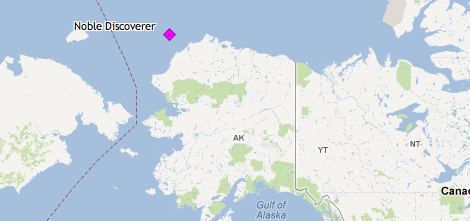On Sunday, Shell began drilling in the Arctic, after the EPA granted a waiver to the company allowing it to exceed regulated air-pollution levels. As of this writing (Sept. 10, 2012, about 1:00 p.m. Eastern), the company has not yet experienced a massive accident spilling hundreds of thousands of gallons of oil on the Alaskan coastline.

Current location of Shell’s drilling vessel, the Noble Discoverer. (Image courtesy of MarineTraffic.com.)
The company can’t actually drill for oil yet, because it has to wait for the arrival of the Arctic Challenger, a vessel specially designed to contain any spill — a ship which itself was cited for illegal hydraulic fluid discharges earlier this year. The vessel doing the drilling, the “Noble” Discoverer (quotes added), is the one that slipped its anchor in July, probably out of excitement about drilling holes in the ocean to let all that oil out. It can only drill to 1,400 feet until the Arctic Challenger (an appropriate name!) arrives.
Part of this detail-attentive company’s response plan in the event that there’s a massive spill involves placing a dome over a broken well head. Some sticklers, though, suggest that Shell’s testing of said dome could perhaps have been more rigorous.
Documents obtained under a Freedom of Information Act request suggest field-testing of a containment dome took place over two hours on 25 and 26 June. The dome, known as a “capping stack”, would be dropped over any stricken wellhead. …
“The first test merely showed that Shell could dangle its cap in 200ft of water without dropping it,” said Kathryn Douglass, a [Public Employees for Environmental Responsibility] staff lawyer. “The second test showed the capping system could hold up under laboratory conditions for up to 15 minutes without crumbling. Neither result should give the American public much comfort.”
Douglass clearly doesn’t give the American people much credit. If we’re not concerned about ships escaping their moorings or pre-polluting Alaskan waters, what makes her think we’ll care that the worst-case solution hasn’t been tested?
Oh, I also forgot to mention that Shell only has two weeks in which to drill, so it will probably be drilling with a great deal of haste, which bodes well.
We’ll update this graphic as necessary.

Update: Shell stopped drilling already, ostensibly because they were concerned about ice encroaching on the drilling vessel. In reality, of course, it was out of disappointment at not having yet oiled any penguins.
They’re going to start drilling again as soon as possible.


